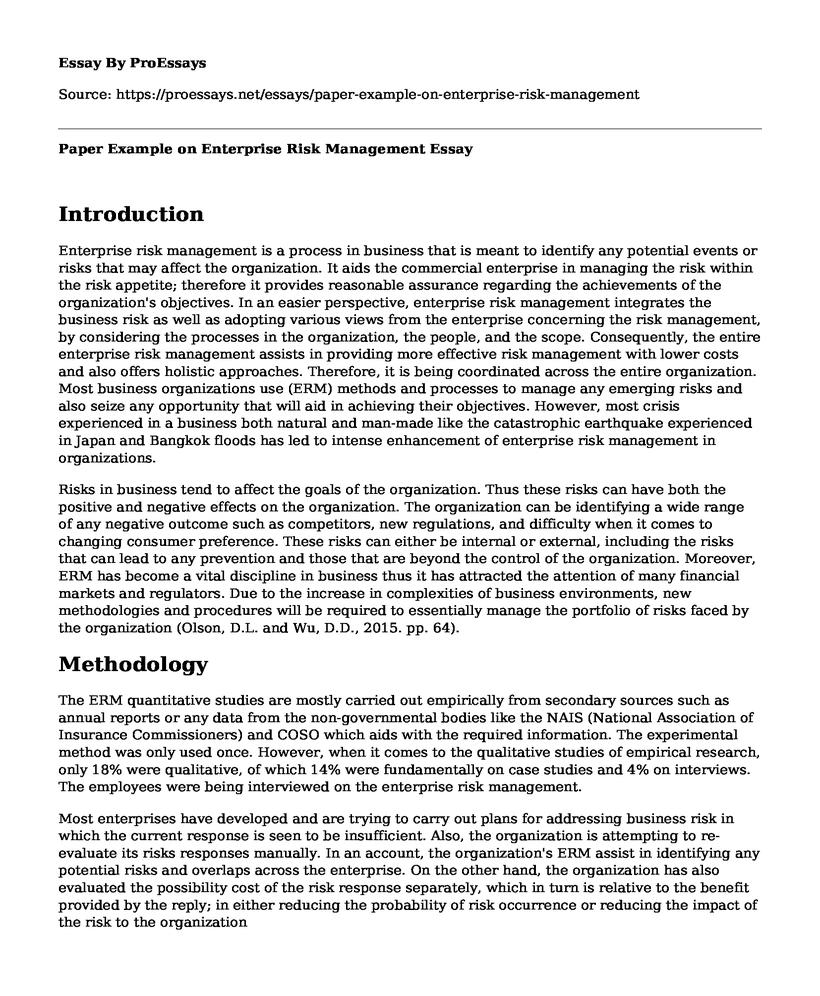Introduction
Enterprise risk management is a process in business that is meant to identify any potential events or risks that may affect the organization. It aids the commercial enterprise in managing the risk within the risk appetite; therefore it provides reasonable assurance regarding the achievements of the organization's objectives. In an easier perspective, enterprise risk management integrates the business risk as well as adopting various views from the enterprise concerning the risk management, by considering the processes in the organization, the people, and the scope. Consequently, the entire enterprise risk management assists in providing more effective risk management with lower costs and also offers holistic approaches. Therefore, it is being coordinated across the entire organization. Most business organizations use (ERM) methods and processes to manage any emerging risks and also seize any opportunity that will aid in achieving their objectives. However, most crisis experienced in a business both natural and man-made like the catastrophic earthquake experienced in Japan and Bangkok floods has led to intense enhancement of enterprise risk management in organizations.
Risks in business tend to affect the goals of the organization. Thus these risks can have both the positive and negative effects on the organization. The organization can be identifying a wide range of any negative outcome such as competitors, new regulations, and difficulty when it comes to changing consumer preference. These risks can either be internal or external, including the risks that can lead to any prevention and those that are beyond the control of the organization. Moreover, ERM has become a vital discipline in business thus it has attracted the attention of many financial markets and regulators. Due to the increase in complexities of business environments, new methodologies and procedures will be required to essentially manage the portfolio of risks faced by the organization (Olson, D.L. and Wu, D.D., 2015. pp. 64).
Methodology
The ERM quantitative studies are mostly carried out empirically from secondary sources such as annual reports or any data from the non-governmental bodies like the NAIS (National Association of Insurance Commissioners) and COSO which aids with the required information. The experimental method was only used once. However, when it comes to the qualitative studies of empirical research, only 18% were qualitative, of which 14% were fundamentally on case studies and 4% on interviews. The employees were being interviewed on the enterprise risk management.
Most enterprises have developed and are trying to carry out plans for addressing business risk in which the current response is seen to be insufficient. Also, the organization is attempting to re-evaluate its risks responses manually. In an account, the organization's ERM assist in identifying any potential risks and overlaps across the enterprise. On the other hand, the organization has also evaluated the possibility cost of the risk response separately, which in turn is relative to the benefit provided by the reply; in either reducing the probability of risk occurrence or reducing the impact of the risk to the organization
Findings
The businesses which have chosen the ERM which has an average financial characteristic that is less opaque with lower return volatility than those that are non-adopters. Moreover, the companies that have adopted ERM have high levels of ownership when it comes to institutions than the non-users. They also have a high value of 4% when it comes to the impact on firm value. The above findings are conflicting, and it might be because of the methodologies used. The earlier method had no relationship between ERM and data proxies of employees whereas the current one is based on the information from the employees.
Limitations
ERM like any other has its disadvantages. According to (Olson et al. 2015 pp.69), in ERM it is difficult for an individual to eliminate the possibility of oversight in a business organization.
Conclusion
In conclusion, the extensive literature review done indicates that there is much work to be done in ERM. Although various research studies have been conducted in this area, it is still a fertile area for research. However, there are conflicts that exist in ERM; there is the disagreement of the impact of ERM to the firm's values. Also, much work is done using the empirical method thus much in-depth research and understanding of the topic need to be done.
Reference
Olson, D.L, and Wu, D.D., 2015. Enterprise risk management (Vol. 3). World Scientific Publishing Company.
Cite this page
Paper Example on Enterprise Risk Management. (2022, May 23). Retrieved from https://proessays.net/essays/paper-example-on-enterprise-risk-management
If you are the original author of this essay and no longer wish to have it published on the ProEssays website, please click below to request its removal:
- Training of Employees Essay Example
- Spending Time in the Urgent and Important Quadrant: Time Management Essay
- Analysis of the Ethical Leadership and Organizational Ethics With Annotated Bibliography
- Paper Example on Funtime Company Incorporates Infrastructure Management
- HIPAA: Protecting Patient Privacy in Healthcare Settings - Essay Sample
- Securing Information: Integrity, Confidentiality and Availability - Research Paper
- Essay Example on The Failed Leadership of J.C. Penney and Ron Johnson







